Alexei Alexeivich Harlamoff stands as a significant, if sometimes overlooked, figure in the landscape of 19th and early 20th-century European art. A Russian painter by birth, he navigated the complex currents of academic training in St. Petersburg and the vibrant, evolving art scene of Paris. Renowned primarily for his sensitive and technically refined portraits, especially those of young girls and women, Harlamoff achieved considerable success during his lifetime, bridging the artistic worlds of his homeland and his adopted France. His journey from humble beginnings in provincial Russia to the salons of Paris is a testament to his talent and determination, while the fluctuating trajectory of his posthumous reputation reflects broader shifts in art historical focus. This exploration delves into the life, work, and legacy of a painter whose delicate portrayals of youth and innocence continue to captivate viewers today.
From Serfdom to the Imperial Academy
Alexei Harlamoff's origins were far removed from the gilded halls of artistic renown. He was born in 1840 near the city of Saratov, situated on the banks of the Volga River, into a family of serfs. This status, a form of bonded servitude prevalent in the Russian Empire, defined the family's early life. A pivotal moment occurred in 1850 when Harlamoff's parents were granted their freedom. This liberation opened doors that would have otherwise remained firmly shut. The family's newfound status allowed the young Alexei, who clearly demonstrated artistic inclinations, to pursue a formal education.
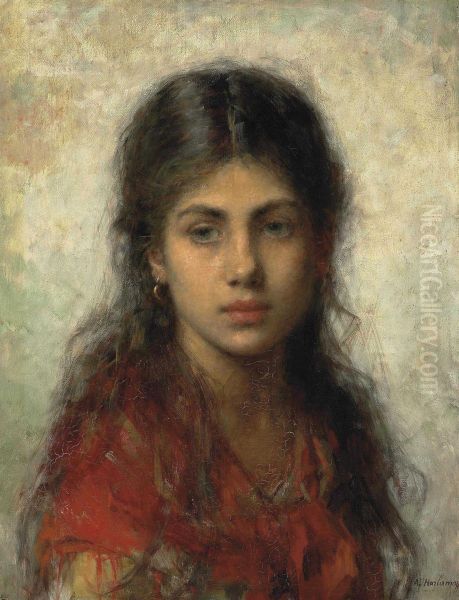
In 1854, at the age of fourteen, Harlamoff gained admission to the prestigious Imperial Academy of Arts in St. Petersburg, initially as an auditor or guest student. This institution was the crucible of official artistic training in Russia, steeped in the traditions of European Neoclassicism and Academic art. Harlamoff quickly proved his mettle, distinguishing himself among his peers. His talent did not go unnoticed; he began accumulating accolades, including a silver medal awarded in 1862 and, significantly, a gold medal in 1863. These awards were not mere honours; they were crucial stepping stones, often providing financial support and travel opportunities for the most promising students. During his formative years at the Academy, he studied under figures like Alexei T. Markov, a history painter and professor who instilled in his students the rigorous discipline of academic drawing and composition. Harlamoff's success within this demanding environment laid the foundation for his future career and provided the essential credentials that would enable him to travel abroad.
The Allure of Paris: New Influences and Opportunities
Winning awards at the Imperial Academy, particularly the gold medal, often came with a coveted prize: a fellowship for travel and study in Europe. For an ambitious Russian artist in the mid-19th century, Paris was the undisputed centre of the art world, a beacon of innovation, tradition, and opportunity. Harlamoff seized this chance, relocating to Paris likely around the late 1860s or early 1870s. This move marked a crucial turning point in his artistic development and professional life.
In Paris, Harlamoff sought out further instruction to refine his skills, particularly in portraiture. He entered the atelier of Léon Bonnat, a highly respected and influential French painter. Bonnat was known for his powerful portraits, characterized by strong realism, often influenced by Spanish masters like Velázquez, and a certain sobriety. Studying with Bonnat provided Harlamoff with exposure to contemporary French academic techniques and a different approach to portraiture than he might have encountered solely in St. Petersburg. Bonnat's emphasis on accurate representation and psychological insight likely resonated with Harlamoff's own inclinations.
Furthermore, Harlamoff benefited from the support and mentorship of fellow Russian expatriate Aleksey Bogoliubov. Bogoliubov, primarily a landscape and marine painter, was a well-connected figure in Paris who actively helped Russian artists navigate the French art scene. He provided guidance, introductions, and likely practical assistance, fostering a sense of community among Russian artists abroad. This network was invaluable for Harlamoff as he established himself in a foreign city.
Navigating the Parisian Art World
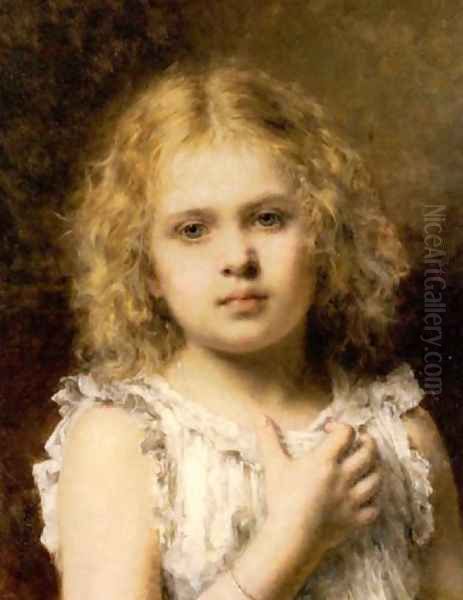
Immersing himself in the Parisian milieu, Harlamoff began to absorb the diverse artistic currents swirling around him. While firmly rooted in his academic training, he was inevitably exposed to the revolutionary ideas of Impressionism, which were gaining momentum during the 1870s. Artists like Claude Monet and Pierre-Auguste Renoir were challenging traditional notions of representation with their focus on capturing fleeting moments, the effects of light and atmosphere, and their use of broken brushwork and a brighter palette. While Harlamoff never fully embraced the Impressionist aesthetic, its influence can arguably be detected in the increased luminosity, softer focus, and more vibrant colour notes found in some of his works from this period onwards.
Harlamoff actively sought recognition within the established structures of the French art world. He began exhibiting his paintings at the prestigious Paris Salon, the official annual exhibition that could make or break an artist's reputation. His participation in the Salon, for instance in 1874, brought his work to the attention of critics, collectors, and the wider public. He also gained international exposure by exhibiting at events like the 1873 Vienna World's Fair. Success in these venues was crucial for building a career, attracting commissions, and establishing a market for his work. His appealing subject matter, particularly his charming depictions of young girls, found favour with French and international audiences.
Influences and Artistic Synthesis: Old Masters and Modern Sensibilities
Harlamoff's mature style represents a sophisticated blend of influences. His foundational training at the St. Petersburg Academy provided him with a strong command of drawing and composition, rooted in classical principles. His time with Léon Bonnat in Paris reinforced a commitment to realism and psychological depth in portraiture. However, Harlamoff also looked further back, drawing inspiration from the Old Masters, particularly those renowned for their handling of light and intimate portrayal of subjects.
Art historians note the discernible influence of Dutch Golden Age painters like Rembrandt van Rijn and Johannes Vermeer, as well as the Flemish master Anthony van Dyck, in Harlamoff's work. From Rembrandt, he may have absorbed lessons in using chiaroscuro (the dramatic interplay of light and shadow) to create mood and focus attention. Vermeer's influence might be seen in the quiet intimacy, subtle light effects, and serene atmosphere of paintings like Harlamoff's Girl Reading. Van Dyck's elegant and sensitive portrayal of aristocracy, especially children, could also have served as a model.
Harlamoff masterfully synthesized these historical influences with contemporary tastes and techniques. He did not simply copy the Old Masters but adapted their principles to his own ends. He combined the meticulous finish and solid structure of academic painting with a softer, more atmospheric quality, possibly gleaned from his observation of Impressionism and the general artistic climate in Paris. This unique fusion resulted in works that felt both timeless and modern, possessing technical polish alongside genuine sensitivity.
Signature Subjects: Portraits of Youth and Innocence
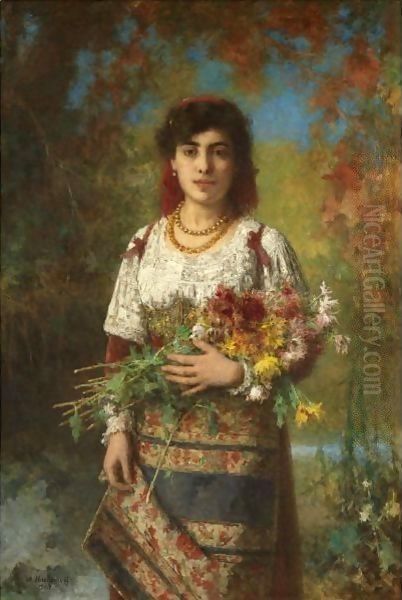
While Harlamoff painted various subjects, including historical scenes like his early success The Prodigal Son (1868) and portraits of prominent adults, he became most celebrated for his depictions of young girls. These portraits form the core of his oeuvre and are the works for which he is best known today. Titles like Girl with a Red Shawl, A Young Beauty, Girl with Flowers, and Gipsy Girl evoke the recurring theme that captivated both the artist and his audience.
These paintings typically feature solitary figures, often posed against simple, dimly lit backgrounds that serve to highlight the subject's face and form. Harlamoff excelled at capturing the delicate features, translucent skin, and lustrous hair of his young models. More importantly, he imbued these portraits with a sense of introspection and gentle melancholy. His subjects often gaze directly at the viewer or are absorbed in a quiet activity like reading or arranging flowers, conveying an air of innocence, vulnerability, and burgeoning self-awareness.
The popularity of these works stemmed from their technical virtuosity and their emotional appeal. They resonated with a late 19th-century sensibility that often idealized childhood and feminine innocence. Harlamoff managed to portray this ideal without excessive sentimentality, grounding his figures with a sense of realism and individual personality. His use of soft light, harmonious colours, and fluid brushwork contributed to the overall charm and tenderness of these portraits, making them highly sought after by collectors in Russia, France, Britain, and America.
Notable Works and Esteemed Patronage
Beyond his signature portraits of girls, several specific works mark important points in Harlamoff's career. His 1868 painting, The Prodigal Son, demonstrated his ability to handle complex narrative subjects within the academic tradition, earning him recognition early on. Later, his move towards portraiture proved highly successful.
A significant connection formed in Paris was with the celebrated Russian novelist Ivan Turgenev. Harlamoff painted several portraits of Turgenev, capturing the likeness and intellectual presence of the writer. This association placed Harlamoff within the prominent circle of Russian expatriate artists and intellectuals living in Paris, which also included the renowned mezzo-soprano and composer Pauline Viardot-Garcia, a close friend of Turgenev. Being part of this influential group undoubtedly enhanced Harlamoff's standing.
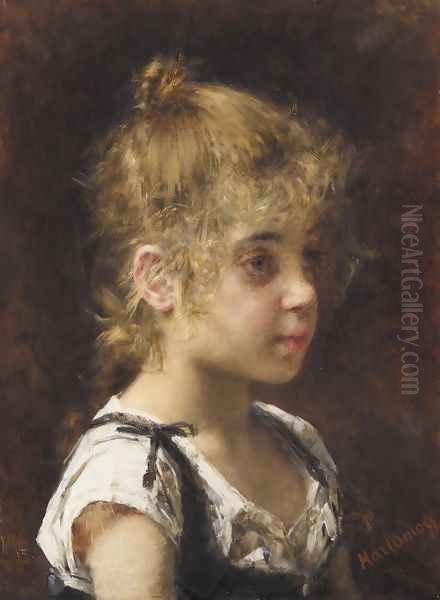
His work also attracted patronage from the highest levels of society. Notably, Tsarina Maria Alexandrovna, the wife of Tsar Alexander II of Russia, acquired some of his paintings. Royal patronage was a significant mark of distinction and further solidified his reputation. Works like Two Girls Arranging Flowers (c. 1878-1880), now housed in a major St. Petersburg museum (likely the State Russian Museum), exemplify the charm and technical skill that appealed to such esteemed collectors. These successes cemented his status as a painter of considerable renown during the 1870s and 1880s.
Connections within the Cultural Sphere: Friends and Critics
Harlamoff's life in Paris brought him into contact with numerous figures from the artistic and literary worlds. His friendship with Ivan Turgenev and connection to Pauline Viardot's circle have already been noted. He also garnered praise from influential French figures like the novelist and art critic Émile Zola. Zola, a champion of Realism and later Naturalism, and a defender of Impressionist painters like Édouard Manet, reportedly admired Harlamoff's work, which lent further credibility to the Russian painter's standing in France.
However, not all critical reception was uniformly positive, particularly back in Russia. Vladimir Stasov, a powerful and often polemical Russian critic, was a fervent advocate for the Peredvizhniki (the "Wanderers" or "Itinerants"). This group, including major figures like Ilya Repin, Ivan Kramskoi, and Vasily Perov, championed a distinctly Russian form of Realism, often focusing on social commentary, historical narratives, and scenes from peasant life. Stasov sometimes criticized artists like Harlamoff whose style he perceived as too cosmopolitan, overly focused on aesthetics, or lacking in national character and social relevance compared to the work of the Peredvizhniki. This highlights the differing artistic ideologies prevalent in Russia and France at the time.
Despite such critiques, Harlamoff maintained connections with the Russian art world. He was involved with organizations like the Association of Russian Artists, even serving as its president in 1896, suggesting continued engagement with his compatriots, possibly within the expatriate community in Paris or during visits back to Russia. His contemporaries in Russia included not only the aforementioned Realists but also historical painters like Vasily Surikov, the masterful landscape artist Isaac Levitan, and the brilliant later portraitist Valentin Serov, who himself navigated between Russian traditions and modern European influences.
Students and the Transmission of Skill
While primarily known for his own output, Harlamoff also played a role in educating the next generation, albeit perhaps less formally than his own teachers. Sources mention him having students, indicating a transmission of his skills and artistic approach. Among those named are Ivan Ilyich Kragliev (whose prominence is unclear, perhaps a minor figure or a name subject to historical obscurity) and Vasili Pavlovich.
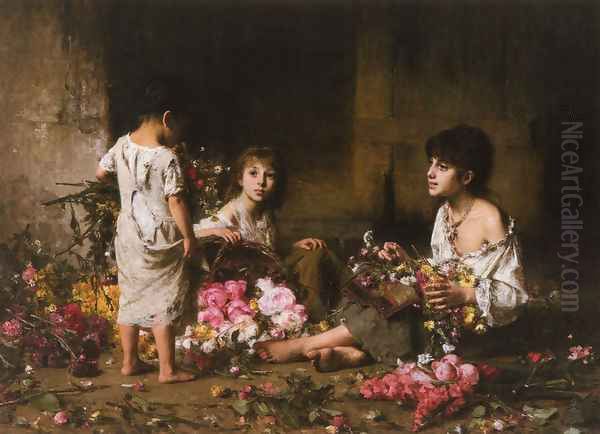
The act of teaching, whether in a formal studio setting or through informal guidance, suggests Harlamoff's willingness to share his knowledge. His students would likely have absorbed his meticulous technique, his approach to capturing likeness and mood in portraiture, and perhaps his methods for achieving the soft, luminous effects characteristic of his work. While none of his known students achieved the same level of fame, his mentorship represents another facet of his engagement with the artistic community.
Later Career and Shifting Reputations
Alexei Harlamoff continued to paint well into the early 20th century, remaining active until his death in Paris in 1925. He witnessed dramatic shifts in the art world, from the consolidation of Impressionism through Post-Impressionism, Fauvism, and the rise of Cubism and abstraction. While his own style remained largely consistent, rooted in the academic and realist traditions he had mastered, he maintained a degree of success throughout his later years.
However, the decades following his death saw a significant decline in his critical fortune, particularly within Russia. During the Soviet era, art history narratives prioritized Socialist Realism and the socially conscious art of the Peredvizhniki. Harlamoff's elegant portraits, often depicting idealized youth or bourgeois subjects, were frequently dismissed as sentimental, lacking ideological weight, or representing an "inappropriate," Westernized aesthetic unsuited to the Soviet narrative of Russian art. Consequently, his work was largely neglected by state institutions and official art history for much of the 20th century.
It was only in the post-Soviet period, beginning in the late 1980s and 1990s, that a reassessment of Harlamoff's contribution began. With the reopening of cultural dialogues and a renewed interest in diverse aspects of Russia's artistic heritage, his paintings started to reappear in exhibitions and gain scholarly attention. Museums began to acquire his works or bring existing holdings out of storage. Today, his paintings are appreciated once more for their technical brilliance and aesthetic charm, and they command significant prices on the international art market, with some major works selling for substantial sums, reflecting a rediscovery by collectors and the public.
An Absence of Controversy
When examining the life and career of Alexei Harlamoff, one notable aspect is the apparent lack of major personal scandals or professional controversies, according to available historical records and the source materials consulted for this overview. While he faced criticism from figures like Stasov regarding his artistic direction, this falls within the realm of typical critical debate rather than constituting a scandal. His personal life appears to have been relatively private and focused on his artistic pursuits.
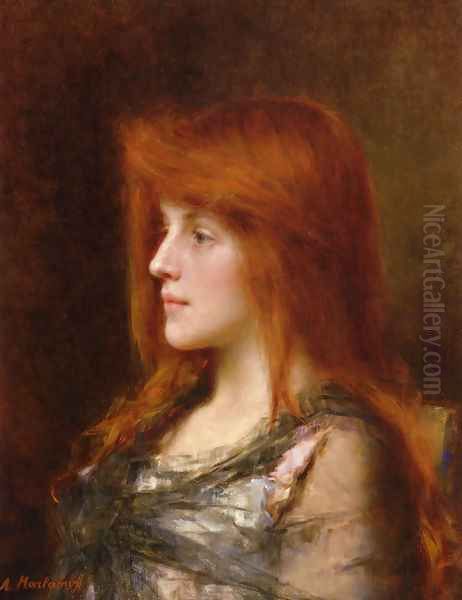
The most significant "issue" associated with Harlamoff is the dramatic fluctuation in his posthumous reputation – the period of high regard during his lifetime, followed by decades of neglect under the Soviet regime, and the subsequent revival of interest. This trajectory speaks more to changing political and cultural ideologies and their impact on art historical canons than to any inherent controversy surrounding the artist himself or his conduct. His career seems to have been one of steady work, professional engagement, and the creation of a body of art that found a receptive audience, particularly outside the more politically charged currents of Russian art criticism.
Enduring Legacy: A Master of Sensitive Portraiture
Alexei Harlamoff's legacy rests primarily on his exceptional skill as a portraitist, particularly his sensitive and idealized depictions of young women and children. He successfully navigated the demanding academic systems of both St. Petersburg and Paris, synthesizing influences from the Old Masters, 19th-century Realism, and the ambient light and colour of contemporary French painting. His work offered a vision of youth and beauty that resonated deeply with audiences of his time and continues to hold appeal.
He stands as an important example of a Russian artist who achieved significant international success, building a career largely based in Paris while maintaining connections to his homeland. Though overshadowed for a period by artists with more overtly national or revolutionary themes, his work has rightfully been re-evaluated and integrated back into the broader narrative of Russian and European art. Harlamoff's paintings, found today in major museums like the Tretyakov Gallery in Moscow and the State Russian Museum in St. Petersburg, as well as in numerous private collections worldwide, serve as enduring testaments to his technical mastery and his unique ability to capture the delicate nuances of expression and the quiet poetry of the inner life. He remains a significant figure for understanding the cross-cultural artistic exchanges and the enduring power of finely crafted portraiture in the late 19th and early 20th centuries.